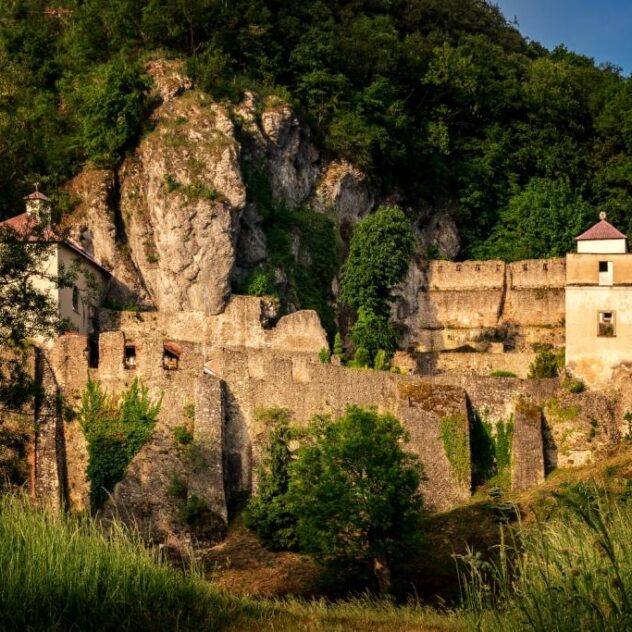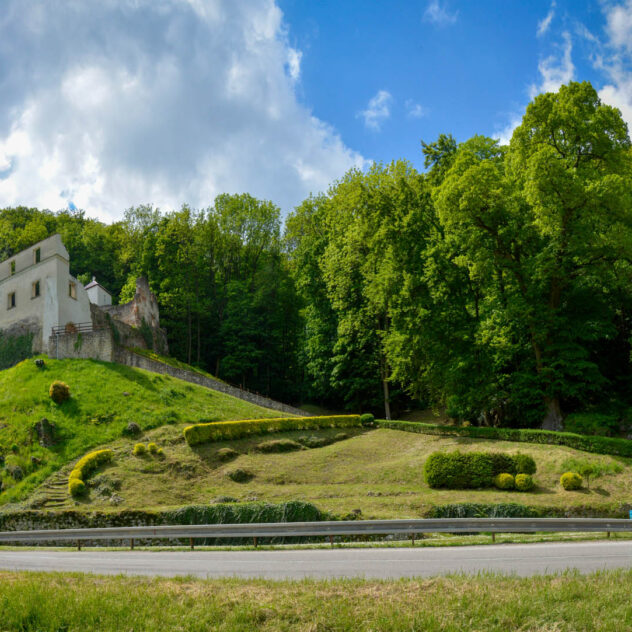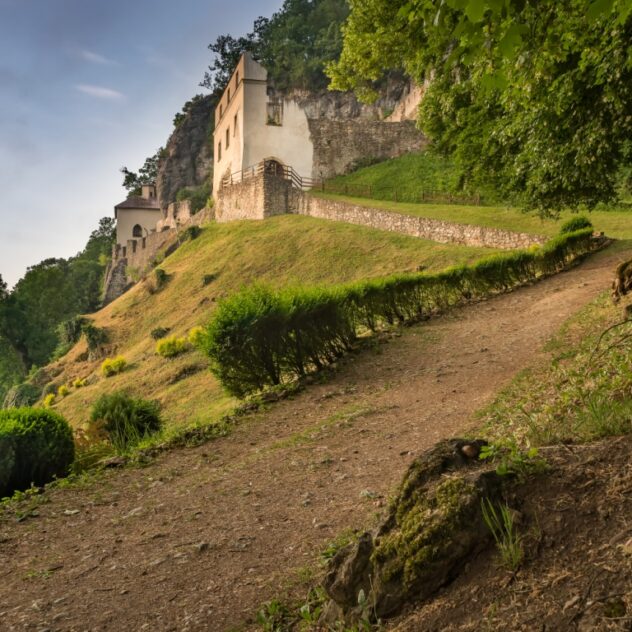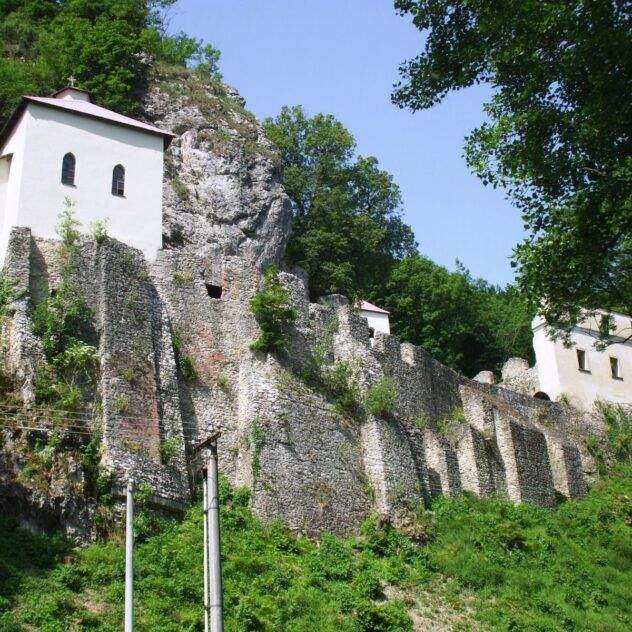Skalka nad Váhom
Information about the pilgrimage site
The oldest historical pilgrimage site in our territory is Skalka nad Váhom, which is located near the town of Trenčín. This area has always had a strategic location and was an ideal place for the founding of settlements. Archaeologists have found traces of the ancient Slavs here in the form of a 9th-century hillfort and burial site, as well as the ruins of an ancient church, which documents the Great Moravian tradition from the early days of the Hungarian state.
Saints Andrew-Svorad and Benadik are venerated at this pilgrimage site. The life of these two ascetic hermits was recorded by Bishop Blessed Maurus, who was their contemporary. St. Andrew-Svorad came from Poland, and lived as a monk in the village of Tropie nad Dunajcom. He later came to Slovakia and settled near Nitra, in a local Benedictine monastery, where he was given the monastic name of Andrej. After a time he withdrew into solitude, where he led a hermit-like and very strict ascetic life. For example, one account of his life tells how, at the beginning of Lent, he asked the abbot for “40 nuts and, satisfied with this food, looked forward with joy to the day of the Holy Resurrection”. His other strict ascetic deeds are also recorded.
Later, the bishop sends him a young assistant disciple, the monk Benadik. Following the example of his teacher, he also embarks on the path of strict asceticism. He was sought out by people from near and far. Despite his popularity with the people, St. Benadik dies a violent death. He was ambushed by bandits, tied up and thrown into the river Váh. For a long time they could not find his body – until people spotted an eagle sitting on the bank of the river Váh for a long time, watching one place all the time. In that place, the intact body of St. Benadik was found. Both saints are buried today in nearby Nitra, in the Cathedral Church of St. Emeram.
This place of pilgrimage is therefore the place of the lives of these two saints. Today it consists of two buildings situated in close proximity: the so-called Little Rock with its Baroque church and the monastery, the so-called Great Rock.
During the communist period, there were efforts to acquire this ancient pilgrimage site for cultural purposes only as well as to exclude religious manifestations. In addition, during communism, the environment of the Great and Little Rock was regularly devastated in the run-up to the annual pilgrimage. After the regime change, the site was significantly renovated and today it is one of the favourite destinations for pilgrims and tourists from near and far, as well as from abroad, mostly from Moravia and Poland.
The main pilgrimage takes place every year on the Saturday and Sunday after 17 July, which is the feast of Sts. Svorad and Benadik. The pilgrimage is preceded by the international meeting of artists Ora et Ars (a tradition since 2008). It is a modern tradition that an annual walking pilgrimage to the ancient Velehrad (in the Czech Republic) starts from this place, pilgrims commemorating the legacy of Sts Cyril and Methodius as the patron saints of Europe.
Tourist attractions in the vicinity
Trenčín – is an old town in western Slovakia, located on the bank of the Váh River. It is one of the oldest towns in Slovakia and has a rich history dating back to the Celtic settlements. Today it is an important economic and cultural centre. It is this rich cultural life that has contributed to the city’s title of European Capital of Culture in 2026. The dominant feature of the city is Trenčín Castle, which is one of the most visited monuments in Slovakia. In the city centre, tourists can also admire other important monuments such as Renaissance houses and palaces, the Capuchin Monastery, where today there is also a museum, the Renaissance Town Hall, the Baroque Church of St. Francis Seraphim, the National National Uprising Monument, and several beautiful parks and gardens, etc.
Thermal and mineral springs and spas – the surroundings of the pilgrimage site are very rich in thermal and mineral springs, there are several spas in the vicinity: the very famous and ancient Trenčianske Teplice, but also Nimnica. Trenčianske Teplice Spa is one of the oldest and most visited spas in Slovakia. This is thanks to the excellent natural sulphur thermal water and the romantic location of the spa. Nimninca Spa is situated in a beautiful natural scenery and the mineral springs have rare healing properties.
Beckov Castle – this national cultural monument has a truly rich history. The first written records date back to the reign of King Bela III of Hungary (mid-12th century). The castle was used by many rulers, especially for defensive purposes. Throughout its history, it has gone through periods of prosperity and decline. After climbing the castle, visitors can enjoy a magnificent view of the entire surrounding countryside. The castle also has a museum which offers a guided tour depicting the history of the adjacent village and the castle itself. Many cultural and social events are held at the castle throughout the year.
Haluzická gorge – church and gorge – Haluzická gorge has been declared a natural monument since 1963. It is located in the village of Haluzice. It was formed by the erosive activity of the stream and is expanding very quickly. The gorge is a system of smaller water dams, which are surrounded by forest and hides beautiful natural wealth. There are also the ruins of a Romanesque church with a 13th century hillfort – popular today for its beautiful setting, which comes across well, especially in photographs.
Čachtice castle – it rises above the village of Čachtice in western Slovakia. This ruin is also nicknamed “the mysterious castle in the Carpathians”. The castle belonged to the system of royal border castles that protected the western borders of the Hungarian Empire. It was built in the first half of the 13th century and substantially enlarged in the 15th century. The castle was made infamous by Countess Elizabeth Báthory. She lived here at the turn of the 16th and 17th centuries. She was nicknamed “the bloody countess” because of her alleged sadistic tendencies. Legend has it that she had many young girls murdered so that she could bathe in their blood. This was to ensure her eternal beauty and youth. The story of the “bloody countess” who died in 1614 has been adapted several times into books and has been the subject of plays and a film.
More tourist attractions in the vicinity of the pilgrimage site Skalka nad Váhom can be found on the website:
- Regional Tourism Organisation Trenčín and surroundings (https://www.oocrtn.sk/)
- Regional Tourism Organisation Trenčín region (https://www.trencinregion.sk/)
- European Capital of Culture 2026 (https://www.trencin2026.sk/)
Accommodation
- Accommodation for pilgrims: the Pilgrimage House Guesthouse also welcomes pilgrims and guests for various spiritual and social events, website: https://putnickemiestoskalka.sk/penzion-putnicky-dom/
- Other private accommodation in Trencin or surrounding villages
Availability
By car
Access by car is the fastest. To Skalka nad Váhom leads the II. class road No. 507. There is a parking lot at the pilgrimage site.
By public transport
The pilgrimage site is reached by public bus transport from Trenčín at an average interval of one hour, the journey takes approximately 15 minutes. The name of the bus stop is Skalka n. Váhom, pilgrimage church. The current timetable can be found at www.cp.sk.
On foot
A newer pilgrimage route for walking pilgrims, which connects two pilgrimage sites: Skalka nad Váhom and a pilgrimage site in the Czech Republic – the ancient Velehrad.
On a bicycle
Bicycle access is limited, being restricted by the busy road.








